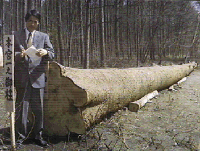 Therefore,
16 poles are necessary to mark 4 corners of 4 Shrines. 16 groups of communities
in Suwa are responsible for the poles, from felling fir trees in March
(Upper) or in the previous year (Lower), dragging them by ropes from the
mountain ("mountain drag") in April to dragging to the Shrines
("town drag") and erecting in May. The whole processes are Divine
Pole Festival.
Therefore,
16 poles are necessary to mark 4 corners of 4 Shrines. 16 groups of communities
in Suwa are responsible for the poles, from felling fir trees in March
(Upper) or in the previous year (Lower), dragging them by ropes from the
mountain ("mountain drag") in April to dragging to the Shrines
("town drag") and erecting in May. The whole processes are Divine
Pole Festival.
The Upper and Lower Shrines take fir logs from different mountains. Traditions and the dragging routes are also different. However, the Upper Shrine is run out of the big fir trees in its mountain, and in 1998 for the first time in its history of 12 centuries, all 16 logs were felled in the same mountain for the Lower Shrine. 8 logs were trucked to the mountain for the Upper Shrines. This picture shows the biggest 1st pole for the Main Shrine of the Upper Shrines, resting on March 29 in the roadside waiting for the Festival.
諏訪大社上社の御柱(おんばしら)を切り出す山に樅の大木が払底したので、1998年は初めて下社用の山から切り出されました。一番大きな本宮一の柱が3月末に道路脇に用意されました。
The mountain drag for the Upper Shrines was held on April 3, 4 and 5, 1998.
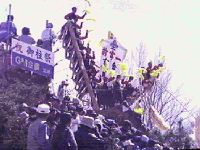 The
most noticeable difference of the poles for the Upper Shrines is that they
have horns at the heads and tails, on which people ride and shout to urge
dragging.
The
most noticeable difference of the poles for the Upper Shrines is that they
have horns at the heads and tails, on which people ride and shout to urge
dragging.
Two highlights along the course are "Hill slide" and "Crossing the river". The log with horns are slid down the hill of about 30 meters with full of people on the log and horns.
上社の山曳きの木落しは30mほどでさほど危険ではありません。メドデコという角を前後に付け、一杯に人が乗った状態で引き摺り下ろします。
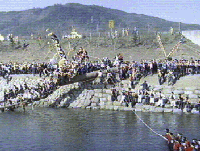
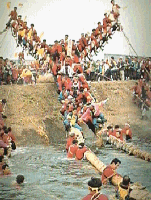
Another highlight is "Crossing the river". There were no bridges 12 centuries ago, therefore logs had to cross the water. This tradition is observed to this date. The water from snow capped mountains is still very cold in early April.
雪解けの冷たい宮川を渡ります。
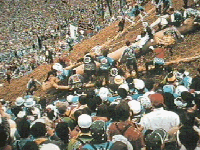 The
mountain drag for the Lower Shrines was held on April 10, 11 and 12, 1998.
There is no horn for the logs for the Lower Shrines. The highlight is "Hill
slide" down the 100 m steep slope. Some people are given the honor
as a prize to ride on the log when it slides down. Those who are not given
this honor wait for the log at the slope and run to the sliding log to
ride on it. They are shaken off, thrown down and often ridden over by the
log. There was one casualty in 1992, but a news reporter told that there
was no casualty this time in 1998.
The
mountain drag for the Lower Shrines was held on April 10, 11 and 12, 1998.
There is no horn for the logs for the Lower Shrines. The highlight is "Hill
slide" down the 100 m steep slope. Some people are given the honor
as a prize to ride on the log when it slides down. Those who are not given
this honor wait for the log at the slope and run to the sliding log to
ride on it. They are shaken off, thrown down and often ridden over by the
log. There was one casualty in 1992, but a news reporter told that there
was no casualty this time in 1998.
A man was talking in the train. His wife forbid him to ride on the log and he promised. But his wife saw her husband riding on the log on television and he was very much scolded.
下社の山曳きのハイライト木落しは100mもの急坂を下るので、大変危険でしばしば死者が出るほどです。
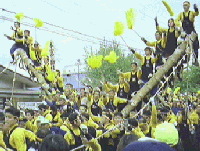
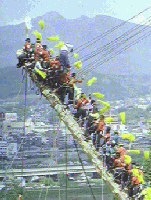
The poles were draged in the town to The Upper Shrines on May 3 and 4. Participants got on the horns attached to the poles and shouted to encourage dragging.
Eventually, on May 4 and 5, the poles were erected at the four corners of the Upper Shrines. Horns were removed and participants rode on the pole until it was erected vertically. The mountain in the background is Mt. Yatsugatake.
5月3/4/5日は上社の里曳と曳建てでした。柱の両端にあった角のようなメドデコは外され、頭部のホゾの部分は山型に切り落とされ(冠落し)、底部のホゾはそのまま埋められます。八ヶ岳を背景に前宮一之柱は、神事・冠落しも含めて6時間かけて建ち上がりました。
Town drag for the Lower Shrines
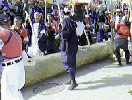
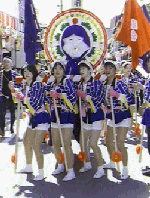
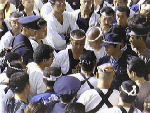
The town drag of the divine poles for the Lower Shrines was held on May 9 - 11. It used to be a men-only festival, but these years the front line girls of the local bank participate shouldering a festival load. Men makes a quarrel for initiatives while policemen are watching.
下社の里曳きは5/9-11でした。諏訪信用金庫のお嬢さんが長持を担ぎます。男達は時々険悪になりますが、警官が睨んでいるせいか手出しはしませんでした。
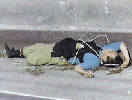
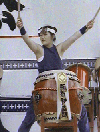
A participant is too tired, maybe drunken, and resting by the roadside. A woman is participating in drumming.